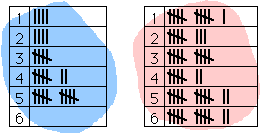Manipulative
| |
Materials: overhead spinner, blank spinner mat, regular six-sided die, 4 beans, paper cup,
coin, paper bag (containing 10 blue, 10 red and 10 yellow tiles), full deck of cards.
- Roll a regular six-sided die about 20 times. Keep track of the values rolled in a tally chart. Repeat. Compare your first tally chart with the second. Are they identical? Why?
- Repeat the above experiment using a spinner of your choice (although the spinner must have two or more regions with differing values).
|
| |
- Repeat the above experiment rolling 4 beans from a paper cup.
- Repeat the above experiment, but flipping a coin 20 times.
- Repeat the above experiment using a full deck of cards. Keep track of how many you draw from each suit of cards.
- Repeat the experiment, but drawing colored tiles from the paper bag.
|

|
|

